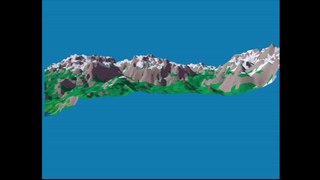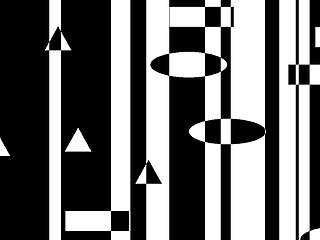
The painter's algorithm is an algorithm for visible surface determination in 3D computer graphics that works on a polygon-by-polygon basis rather than a pixel-by-pixel, row by row, or area by area basis of other Hidden-Surface Removal algorithms. The painter's algorithm creates images by sorting the polygons within the image by their depth and placing each polygon in order from the farthest to the closest object.

Scanline rendering is an algorithm for visible surface determination, in 3D computer graphics, that works on a row-by-row basis rather than a polygon-by-polygon or pixel-by-pixel basis. All of the polygons to be rendered are first sorted by the top y coordinate at which they first appear, then each row or scan line of the image is computed using the intersection of a scanline with the polygons on the front of the sorted list, while the sorted list is updated to discard no-longer-visible polygons as the active scan line is advanced down the picture.
In digital signal processing, spatial anti-aliasing is a technique for minimizing the distortion artifacts (aliasing) when representing a high-resolution image at a lower resolution. Anti-aliasing is used in digital photography, computer graphics, digital audio, and many other applications.

Texture mapping is a method for mapping a texture on a computer-generated graphic. "Texture" in this context can be high frequency detail, surface texture, or color.

A depth buffer, also known as a z-buffer, is a type of data buffer used in computer graphics to represent depth information of objects in 3D space from a particular perspective. The depth is stored as a height map of the scene, the values representing a distance to camera, with 0 being the closest. The encoding scheme may be flipped with the highest number being the value closest to camera. Depth buffers are an aid to rendering a scene to ensure that the correct polygons properly occlude other polygons. Z-buffering was first described in 1974 by Wolfgang Straßer in his PhD thesis on fast algorithms for rendering occluded objects. A similar solution to determining overlapping polygons is the painter's algorithm, which is capable of handling non-opaque scene elements, though at the cost of efficiency and incorrect results.

Shadow volume is a technique used in 3D computer graphics to add shadows to a rendered scene. It was first proposed by Frank Crow in 1977 as the geometry describing the 3D shape of the region occluded from a light source. A shadow volume divides the virtual world in two: areas that are in shadow and areas that are not.
In computer science, a mask or bitmask is data that is used for bitwise operations, particularly in a bit field. Using a mask, multiple bits in a byte, nibble, word, etc. can be set either on or off, or inverted from on to off in a single bitwise operation. An additional use of masking involves predication in vector processing, where the bitmask is used to select which element operations in the vector are to be executed and which are not.

In 3D computer graphics, hidden-surface determination is the process of identifying what surfaces and parts of surfaces can be seen from a particular viewing angle. A hidden-surface determination algorithm is a solution to the visibility problem, which was one of the first major problems in the field of 3D computer graphics. The process of hidden-surface determination is sometimes called hiding, and such an algorithm is sometimes called a hider. When referring to line rendering it is known as hidden-line removal. Hidden-surface determination is necessary to render a scene correctly, so that one may not view features hidden behind the model itself, allowing only the naturally viewable portion of the graphic to be visible.

In computer graphics, a shader is a computer program that calculates the appropriate levels of light, darkness, and color during the rendering of a 3D scene—a process known as shading. Shaders have evolved to perform a variety of specialized functions in computer graphics special effects and video post-processing, as well as general-purpose computing on graphics processing units.
Color digital images are made of pixels, and pixels are made of combinations of primary colors represented by a series of code. A channel in this context is the grayscale image of the same size as a color image, made of just one of these primary colors. For instance, an image from a standard digital camera will have a red, green and blue channel. A grayscale image has just one channel.

A stencil buffer is an extra data buffer, in addition to the color buffer and Z-buffer, found on modern graphics hardware. The buffer is per pixel and works on integer values, usually with a depth of one byte per pixel. The Z-buffer and stencil buffer often share the same area in the RAM of the graphics hardware.

Shadow mapping or shadowing projection is a process by which shadows are added to 3D computer graphics. This concept was introduced by Lance Williams in 1978, in a paper entitled "Casting curved shadows on curved surfaces." Since then, it has been used both in pre-rendered and realtime scenes in many console and PC games.
In computing, indexed color is a technique to manage digital images' colors in a limited fashion, in order to save computer memory and file storage, while speeding up display refresh and file transfers. It is a form of vector quantization compression.

In the field of 3D computer graphics, deferred shading is a screen-space shading technique that is performed on a second rendering pass, after the vertex and pixel shaders are rendered. It was first suggested by Michael Deering in 1988.
Screen space ambient occlusion (SSAO) is a computer graphics technique for efficiently approximating the ambient occlusion effect in real time. It was developed by Vladimir Kajalin while working at Crytek and was used for the first time in 2007 by the video game Crysis, also developed by Crytek.
Order-independent transparency (OIT) is a class of techniques in rasterisational computer graphics for rendering transparency in a 3D scene, which do not require rendering geometry in sorted order for alpha compositing.

InfiniteReality refers to a 3D graphics hardware architecture and a family of graphics systems that implemented the aforementioned hardware architecture that was developed and manufactured by Silicon Graphics from 1996 to 2005. The InfiniteReality was positioned as Silicon Graphics' high-end visualization hardware for their MIPS/IRIX platform and was used exclusively in their Onyx family of visualization systems, which are sometimes referred to as "graphics supercomputers" or "visualization supercomputers". The InfiniteReality was marketed to and used by large organizations such as companies and universities that are involved in computer simulation, digital content creation, engineering and research.
Deep image compositing is a way of compositing and rendering digital images that emerged in the mid-2010s. In addition to the usual color and opacity channels a notion of spatial depth is created. This allows multiple samples in the depth of the image to make up the final resulting color. This technique produces high quality results and removes artifacts around edges that could not be dealt with otherwise.
In computer graphics, A-buffer, also known as anti-aliased, area-averaged or accumulation buffer, is a general hidden surface mechanism suited to medium scale virtual memory computers. It resolves visibility among an arbitrary collection of opaque, transparent, and intersecting objects. Using an easy to compute Fourier window, it increases the effective image resolution many times over the Z-buffer, with a moderate increase in cost.
This is a glossary of terms relating to computer graphics.










